| Please access the following URL if you want to secure using SSL. All pages in the site will be secure pages. |
https://secure02.blue.shared-server.net/www.fish-food.co.jp/message english 9.2023.html |
Welcome to FISH FOOD TIMES
Sep. 2023 issue No.237

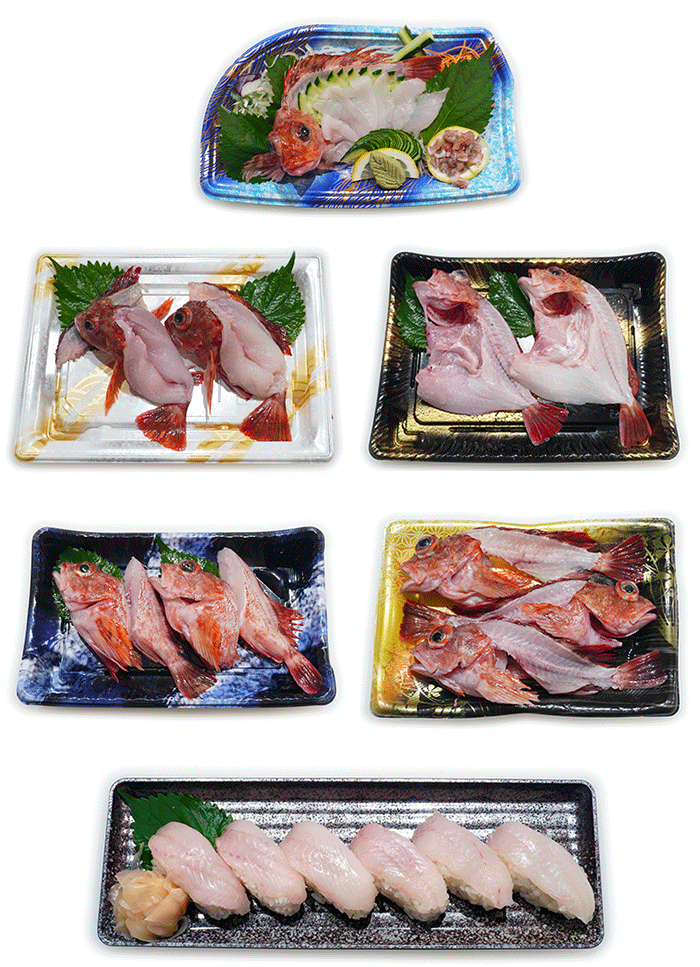
Scorpionfish S.K.U.
Fish of great interest to non-anglers
According to the analysis data always published in real time by Google Analytics, which analyzes the access status of the website, in terms of the number of page impressions of FISH FOOD TIMES, March 2017 issue No. 159 hairy stingfish is always the top rank. In addition, August 2016 issue No. 152 longtail tuna and July 2016 issue No. 151 stingray are also regulars who come to the top of the page display count.
The trend that can be inferred from the contents of these pages that are accessed is that they want to know about fish that are not familiar at the fish market on a daily basis using the power of the net. Among them, the hairy stingfish is considered to be one of the fish that strongly shows such interest.
Based on that fact, I noticed something unexpected. In this way, hairy stingfish was treated as a theme in the past, and in the October issue of No. 70 in 2009, which was quite old, yellowbarred red rockfish was also dealt with lightly and simply. (Pages older than No. 100 do not have a tracking code to be analyzed.) However, the commonly known scorpionfish suborder Rockfish family Scorpionaceae genus Scorpionfish in the image below was not yet treated as a theme. It's not that I intentionally avoided this, but rather that for some reason it fell out of the list of candidates to be selected as a theme.

Scorpionfish live in rocky reefs across Japan from Hokkaido to the Nansei Islands, and do not swim very actively, living on the ocean floor at depths of up to 200 meters, and feed on small fish such as fry and young fish by swallowing them whole with their large mouths. The scorpionfish I purchased had fish hooks mixed in as shown in the image below. This is by no means uncommon, and when fishing, the line may break and the hook may remain in the throat, so care must be taken when cooking.
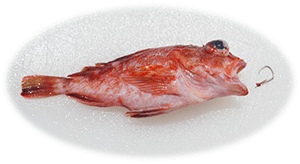
Of the 10 scorpionfish I purchased this time, only one had a hook left. You should be prepared for such a probability that fish hooks are included, and on this day, the person in charge of a fish shop I am familiar with told me about the possibility of fish hooks being mixed in when purchasing scorpionfish, and it actually happened.
The bottom image is the 10 scorpionfish I purchased.
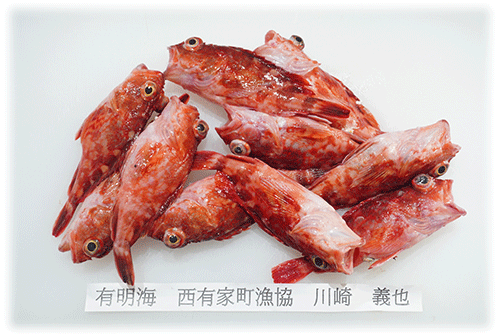
About 50 scorpionfish were contained in a thin styrofoam box containing a tag with the name of the fisherman. I picked 10 of them by hand and they were almost the same size,and they were so uniformly sized that it was pointless to choose, and they were all around 100g each.
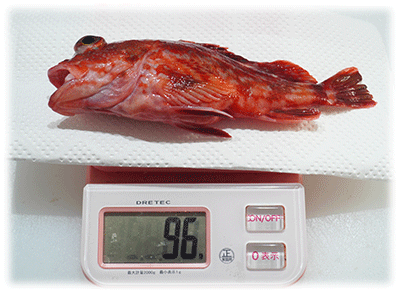
Of course, these scorpionfish were just delivered from the fish market this morning, so they were extremely fresh, and the purchase price was 1,300 yen for 10 fish. Since 10 fish weigh about 1 kg, the unit price per kg is 1,300 yen, which may not seem cheap, but it is only 130 yen per fish.
Such a small fish weighing only about 100g is troublesome to cook, so it is one of the fish that not only general customers but also sales personnel who are in a position to sell fish dislike purchasing and selling. The scorpionfish, despite being a very tasty fish, is not so highly valued and seems to have a low market value, but this size is not a juvenile but an average sized adult.
But what about the 6 types of products that make full use of the 10 scorpionfish in the opening image? If you are in charge of selling fish, how much selling price would you set for each product? It's an example of what can be done if you don't spare any effort, but there are people who take it positively, and conversely, there are people who have a negative view that it can't be done, and there should be various reactions.
These proposals are based on the knowledge that various opinions will arise. If you're even slightly interested, read on for the article below, but let's just say that the information isn't necessarily useful for everyone.
Challenges presented by scorpionfish cooking, which is considered troublesome
Scorpionfish fishing can be easily done in places close to the coast such as embankments and tetras, so it is a target fish that even beginners can get close to. In addition, once the scorpionfish bites into the bait with its large mouth, it does not let go easily, so it is easy to achieve good fishing results. Therefore, for anglers, it is also a fish that is ridiculed as "What a pity, it's a scorpionfish...".
This tendency to ridicule has a similar aspect in the fish market. For example, I sometimes see them put in a tray as they are round, treated lightly, and sold at a relatively low price, but I have not seen them sell well. One of the reasons why sales of scorpionfish are not so good is that both sellers and buyers think that scorpionfish are small and difficult to handle. Relatively large scorpion fish have a high transaction price at the fish market, so they are purchased by vendors who have customers such as Japanese restaurants and kappo, so only small scorpionfish are lined up in ordinary fish shops.
Small size scorpionfish have a relatively low purchase price, so the selling price is reasonably affordable. However, the scorpionfish has a large head but a small body, and although it eats only a few parts, it is troublesome to cook, therefore, it is not positioned as a popular fish for both sellers and buyers.
In the past, I have seen scorpionfish sold whole in packs at the fish section of a supermarket where I was instructed, and advised them to cook and sell them because they would not sell as they are. However, he only responded appropriately, and in the end I saw many times that the price reduction sticker was put on it and it was disposed of. This is probably because sellers also think, "Even if you spend a lot of time cooking small scorpionfish, it won't sell at a decent price anyway, so it's pointless to do such a thing.''
Considering the so-called "balance between cost and effect", it seems that they want to prioritize work that can generate sales and profits more efficiently. This idea cannot be denied unconditionally, so let's just accept it for now. However, as a result of pushing such a way of thinking in supermarket fish departments all over the country for the past decades, the ratio of in-store sales in the fisheries department continues to decrease year by year. According to the supermarket sales statistics survey, the sales composition ratio in July 2023 is 11.0% for livestock, 13.2% for fruits and vegetables, and 11.2% for prepared dishes, but only 8.5% for fisheries.
In other words, there is something in common with what I have said over and over again that "efficiency, rationalization, and labor-saving have ruined the fisheries sector."
Raw Atlantic salmon flown in from Norway remains at a very high price due to the Ukrainian war and the weak yen. Large-sized farmed fish of this kind are often delivered after being grated into three pieces, so it is easy and very efficient to process them into slices, sashimi, or sushi at the fish department workshop. Nowadays, fish that require only such easy and rational work are welcomed, but on the contrary, small and troublesome fish such as scorpionfish are avoided from the purchase stage and disappeared from the fish department of supermarkets.
Farmed salmon imported from foreign countries and sold at high prices can be found in the fish department. However, affordable domestic scorpion fish is not available in the fish department, and something similar has been occurring in supermarket fish departments across Japan for a long time. As a result, the assortment of domestic fish became increasingly scarce in the fish departments of supermarkets, and only limited types of cultured fish and thawed fish stood out, losing their appeal. Fish specialty stores like Kakujyo Gyorui are stealing customers away from supermarkets by stocking a wide variety of domestically produced fish and by providing face-to-face sales floor cooking services that customers dislike.
What is noteworthy about Kakujyou Gyorui is that they "spend more and more staff on the sales floor'' and they have the know-how to turn all the fish they purchase into cash, which is surprising as their loss rate is less than 1%. In other words, there is a world unrelated to the "labor-saving'' efforts that are still repeated in the fish departments of supermarkets.
The author believes that the key to reviving the declining fish section of supermarkets is to "review domestically produced fish." One of the symbols of this is the scorpionfish, which is the theme of this month's issue. I believe that whether or not it is possible to commercialize small scorpionfish and make a profit by selling them can be seen as one of the tests of the seriousness of running a fish store.
Commercialization of scorpionfish
Now, I prepared the scorpionfish, which is considered to be a tedious task, and I will introduce it to you in the image below. First, remove the small scales and separate the gills, which requires a little bit of a struggle.
| Separation work of gills that is a little bit of a struggle | |
|---|---|
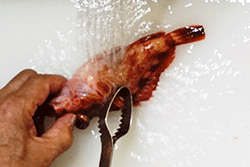 |
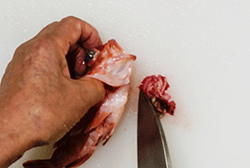 |
| 1�CThe scales are small and there are many, so remove them carefully, including the head, while pouring running water over them. | 4�CPull the fish to the left with your left hand, and while keeping the Deba knife in contact with the gills, press the gills against the cutting board to separate them. |
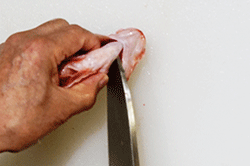 |
 |
| 2�CApply the belly of the Deba knife to the gills. | ��The gills of scorpionfish are difficult to remove despite their small size. The key to making this work easier is �@ Cutting the gill membrane. |
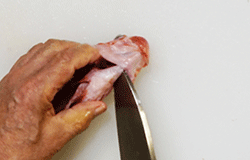 |
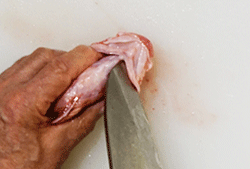 |
| 3�CTilt the blade to the right while keeping the belly of the knife on the gills, and pull the fish body to the left with the left hand. | ��Point �A To make gill membrane removal easier is to separate the base of the gills that are in contact with the kama area. |
After removing the scales and gills from all 10 scorpionfish, we commercialized 2 fish for deep-frying.
| Cooking process for deep-fried scorpionfish | |
|---|---|
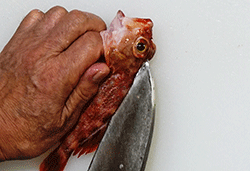 |
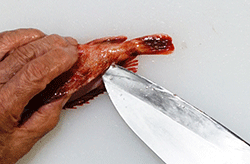 |
| �P�CMake a notch near the dorsal fin on the upper body side. | �U�CCut beyond the backbone and cut open to the edge of the anal fin. |
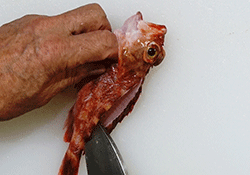 |
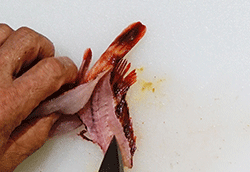 |
| �Q�CCut open the centralbone toward the backbone. | �V�CHold the centralbone with a deba knife, grab the fish body with your left hand, and spread it to the left and right. |
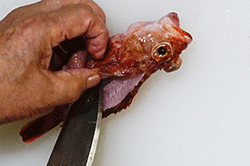 |
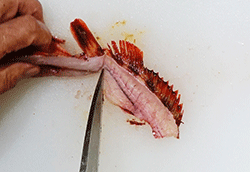 |
| �R�CCut the belly bone as well, and cut it open close to the skin at the anal fin. | �W�CSeparate the part where the base of the anal fin connects to the central bone. |
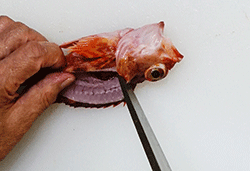 |
 |
| �S�CSeparate the centralbone and the base of the head. | �X�CFinally cut off the thin part of the centralbone closest to the caudal fin. |
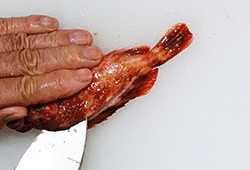 |
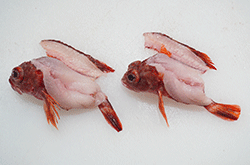 |
| �T�CCut it open from the edge of the dorsal fin on the lower body side. | �P�O�AScorpionfish with separated centralbone for deep frying. |
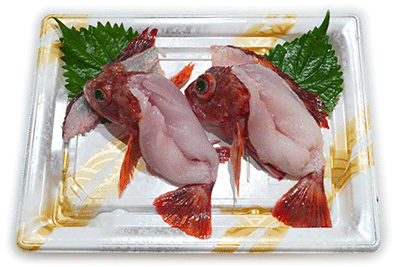 |
|
| Product with 2 scorpionfish for deepfried | |
The next step is to commercialize scorpionfish for boiling. Considering the application to cooking later, this product was made for boiled fish for convenience. If anything, it may be more convenient to use it for dried fish.
| Scorpionfish merchandising process for boiled fish (dried fish) | |
|---|---|
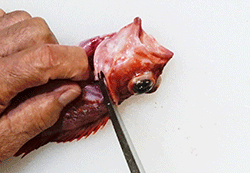 |
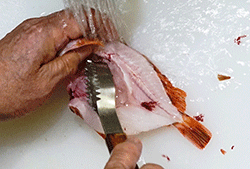 |
| �P�CCut up to the centralbone at the base of the neck, but do not separate the centralbone. | �T�CWash away remaining tenacious white air bladders and lumps of blood using tools while pouring water on them. |
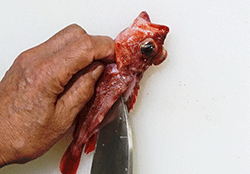 |
 |
| �Q�CCut open along the dorsal fin on the upper body side from the cut part at the base of the neck. | �U�CA state in which internal organs and lump of the blood have been thoroughly washed away. |
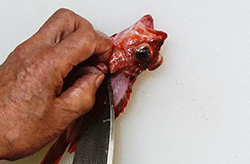 |
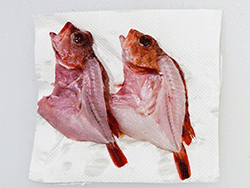 |
| �R�CCut past the central bone and through the belly bone, then cut it open. | �V�CPlace the fish on kitchen paper to remove any moisture from it. |
 |
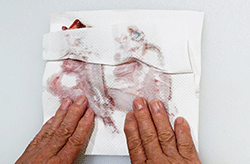 |
| �S�CCut open until near the skin of the rump edge. | �W�CCover the fish with kitchen paper to absorb moisture from the surface of the fish. |
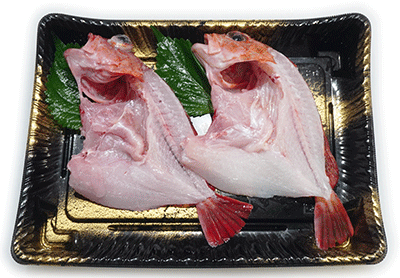 |
|
| Scorpionfish merchandising for boild fish (dried fish) | |
The next two fish are for miso soup. This is simply cutting the fish in half with the head on, so there is nothing special about the process, but since these are two of the 10 fish, I will write them down.
| Scorpionfish commercialization process for miso soup | |
|---|---|
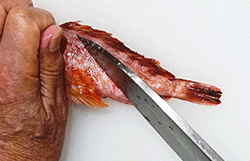 |
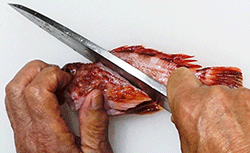 |
| �P�CApply the cutting edge on the diagonal line connecting the front of the scorpionfish's first dorsal fin and the front of the first anal fin. | �R�CPress the hard centralbone firmly with the tip of the knife and cut it into about half its size. |
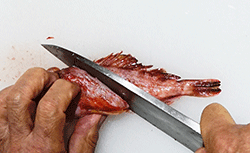 |
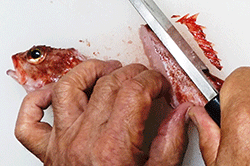 |
| �Q�CPush the tip of the blade into the diagonal direction you are aiming for. | �S�CRemove the hard dorsal fin by cutting it with the blade root part. |
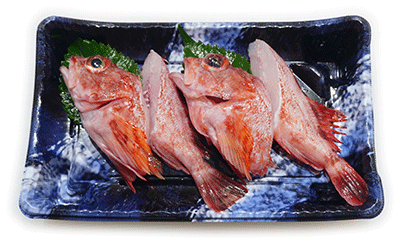 |
|
| Scorpionfish commercialization for miso soup | |
Of the remaining four fish, one was made into figure sashimi and three were made into nigiri sushi. Figure sashimi needs head and centralbone, and nigiri sushi doesn't need head or centralbone. However, it would be a waste to throw away the head and centralbone of the scorpionfish without using anything, so I decided to keep these as a product to look good.
It may seem a little strange, but only bones of the same shape as those cooked with the head and centralbone connected for figure sashimi were commercialized as "Bone rice crackers for deep fried". Therefore, the shape of all bones is basically the same.
| Scorpionfish figure sashimi preparation and Bone rice crackersfor deep fried cooking process | |
|---|---|
 |
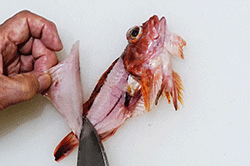 |
| �P�CMake a cut from the base of the neck on the upper body side to the back of the pectoral fin. | �U�CContinue cutting until you reach the edge of the dorsal fin and separate the lower body. |
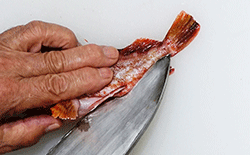 |
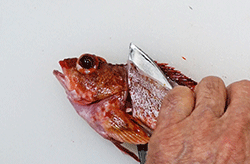 |
| �Q�CMake a cut at the anal fin on the upper body side and cut it open to the centralbone. | �V�COnce again, return to the upper body side and cut off the adhesive part of the backbone toward the head. |
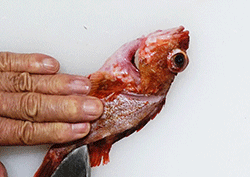 |
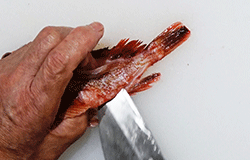 |
| �R�CCut open from the edge of the dorsal fin on the upper body side to the centralbone. What you need to be careful about here is to purposely finish the work on the upper body at this stage. | �W�CNow cut the glued part of the backbone toward the tail. |
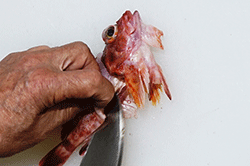 |
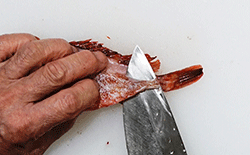 |
| �S�CCut it open from the edge of the anal fin on the lower body side. | �X�Cinally, separate the upper part. |
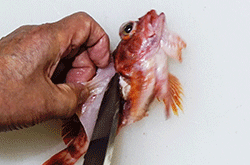 |
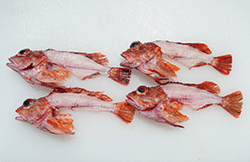 |
| �T�CDon't stop cutting at the backbone, just continue cutting towards the dorsal fin. | 10�CThe state after washing away the stomach and lump of the blood. |
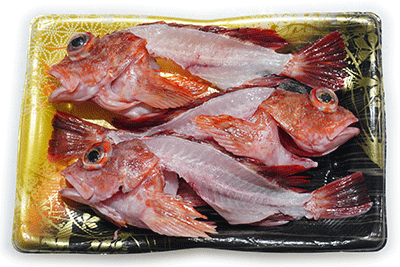 |
|
| Scorpionfish figure sashimi preparation and bone rice crackersi for deep fried | |
Regarding some of the work processes introduced above, I think some readers may be wondering, "Why did you do something like this?" This refers to the process of "turning the upper body inside out and inserting the knife twice.'' This is the key to finishing the three pieces disassembling as neatly as possible when doing figure sashimi. The purpose is to "avoid creating a stepped space between the head and the centralbone.''
Well, if you've done the preparation work for figure sashimi even once, you should be able to understand from experience how difficult the cooking process is. It's the same for large wild sea bream and small scorpionfish, so if you've never tried this method, I recommend you try it. Not only will the yield rate improve, but the centralbone section will also look better, and this little trick will probably come in handy.
Next is the commercialization of figure sashimi and nigiri sushi. As for the work process, I used the uchibiki technique to remove the skin because the scorpionfish is a small fish, but for this reason, the fish was not visible from the overhead camera, and only the author's arm was visible, so the image was omitted.
| Scorpionfish's figure sashimi and part of the nigiri sushi work process | |
|---|---|
 |
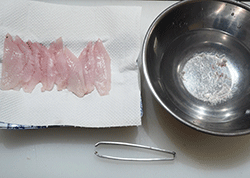 |
| 1�C4 scorpionfish after skinning. | �R�CFill a bowl with water and soak the bone removal tool in it to separate the attached chiai bones. |
 |
 |
| �Q�CPull out the chiai bone with a boning tool. | �S�CHalf body of 4 fish after removing chiai bone. |
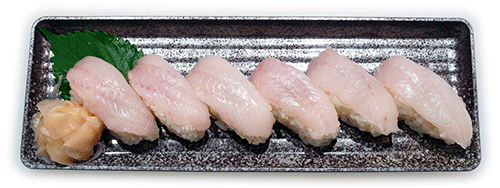 |
|
| Scorpion fish nigiri sushi (Half body was 1 kan, so I did a little more shari and made 20g.) | |
 |
|
| Scorpionfish's figure sashimi �iThe skin is also boiled and chopped for use as Ashirai.�j | |
With this, 6 S.K.U. using 10 scorpionfish was completed. A scorpionfish that costs 130 yen per fish has transformed like this, but do you think that you can't do something like this, or do you think that you should try something similar? Which one are you? However, the real pleasure of scorpionfish should not end here. If you can make the following cooking suggestions well, I think you will be able to put the contents of this article to good use.
Scorpionfish dishes
The best feature of scorpionfish cooking is that it is not very difficult and can be eaten easily and deliciously. Among them, miso soup is the easiest.


Slice the scorpionfish into two pieces, lightly make yushimo, and add to the cold kelp water. Simply boil this until cooked through, then lower the heat and dissolve the miso. Add chopped green onions to the bowl and finish.
Next is boiled scorpionfish. Since the scorpionfish is small and boiled whole, it doesn't look good, so I opened it so that it doesn't look inferior to the size of the dish.

| Boiled scorpionfish cooking process | |
|---|---|
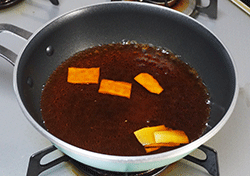 |
 |
| �P�CAdd ginger to the broth and bring to a boil. | �R�CCover with a drop-lid and occasionally use a ladle to scoop out the broth and pour it over the top of the fish. |
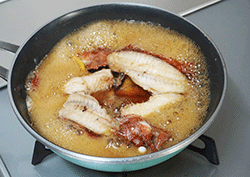 |
 |
| �Q�CCook over low heat for about 5 minutes. | �S�CFinally, add the shishito peppers and complete. |
 |
|
| Boiled scorpionfish | |
This time it's deep fried fish, which can be said to be the main dish of scorpionfish. This dish is delicious not only for its meat, but also for its bones. Also, the texture of the bones is exquisite and easy to eat, and the size is just right to put it in your mouth, all of which are extremely satisfying dishes.

| Scorpionfish deep fried fish cooking process (twice fried) | |
|---|---|
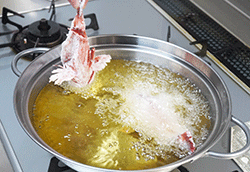 |
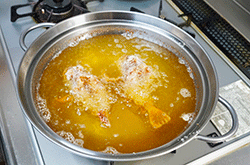 |
| �P�CSeason the scorpionfish with salt and pepper, sprinkle with potato starch and place in oil at 160 degrees. | 4�CRaise the temperature of the oil to 180 degrees and start frying twice. |
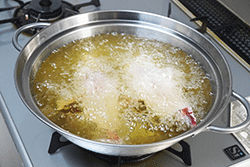 |
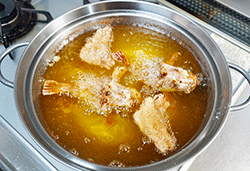 |
| 2�CWait for about 8 minutes until it becomes crispy. | 5�CIn addition to frying the centralbone part twice, fry it at a high temperature of 180 degrees for about 2 minutes. |
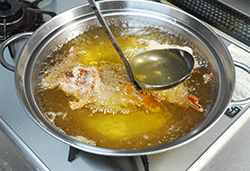 |
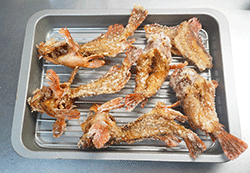 |
3�CUse a ladle to scoop the oil over and over again on the parts where the bottom is shallow and does not go into the oil. |
6�CA scorpionfish that has been fried twice. Besides 2 deep fried fish, there are 3fishs worth of bone rice crackersi head and centralbone. |
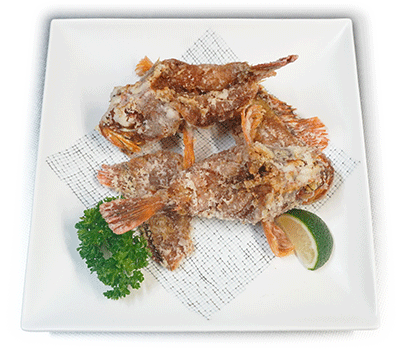 |
|
| Scorpionfish deep fried fish (twice fried) | |
A delicious dish called deep fried scorpionfish was created. But this is not the end of the story. A bonus dish that is just as good as this has been completed. That is the image below.

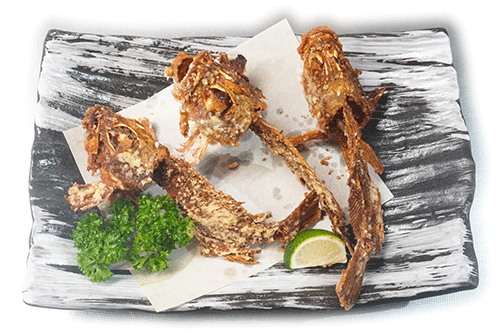
The name of the dish is "Bone rice crackers deep fried fish of scorpionfish". Actually, this is my first time eating scorpionfish in this way. I was sure that it would be just as delicious as fried scorpionfish, but I thought I wouldn't know what kind of taste it was until I tried it.
However, when I tried it, it was so delicious that I thought, "I can eat more of these !...'' While eating this dish, I remembered the eel bone cracker. I love the eel bone rice crackers served at eel restaurants, and I love it so much that if there is only a small amount of bone rice crackers served before the eel dish is served, I will order more.I felt that these were delicious bone rice crackers that were even more satisfying.
Although it is small, it is a fish with great potential.
Well, this month's issue turned out to be longer than I expected, but I'd like to summarize it now. What I would like to express as a conclusion is the great potential of the scorpionfish. There is an old saying that "Japanese pepper is small and spicy,'' but I feel that there are few other fish that are so small and can be used in so many different dishes.
It has been a long time since sales in the fisheries section of supermarkets have been on a gradual decline year by year. Nowadays, there is a fisheries section that relies on farmed and thawed fish imported from foreign countries, and has no choice but to accept price increases without permission, and as a result, it is struggling to maintain profits. When we learn the reality of this situation, we often feel not only regretful, but even angry.
After all, for the fish sector, the current situation where they have no choice but to endure and continue using air-freighted raw salmon no matter how high the purchase price becomes is an unwelcome abnormal situation. Rather, I would like them to use their wisdom on how to sell fish like scorpionfish, which are small but relatively inexpensive domestically produced fresh fish and have great potential.
Currently, Japan's fishing industry is being forced into a difficult situation due to tritium-treated water. China, which is using this as propaganda, has already released approximately 6.5 times the amount of radioactive material tritium than the annual amount of treated water from TEPCO's Fukushima Daiichi Nuclear Power Plant that is scheduled to be released into the ocean. Japan doesn't have to put aside its own taint and export seafood to countries like China, which unilaterally attack other countries.
It is precisely at times like these that people in the fish sales industry should actively purchase and sell domestically produced fresh fish.
It is out of the question for people involved in fisheries to bargain for fish just because it is a fish off the coast of Fukushima. If you buy fresh fish of the same size and freshness as in other regions, you should buy it at the same price. When people in the fisheries industry think about what they can do for Japan's fisheries industry, one option is to actively purchase and sell domestically produced fresh fish.
Scorpionfish is also one of the typical domestic fresh fish. There should be various other domestic fresh fish in a similar position, so I would like you to actively purchase and sell various domestic fresh fish.
| Please access the following URL if you want to secure using SSL. All pages in the site will be secure pages. |
https://secure02.blue.shared-server.net/www.fish-food.co.jp/message english 9.2023.html |
An opinion and the communication are to iinfo@fish food times
Date of updating 1 Sep. 2023
